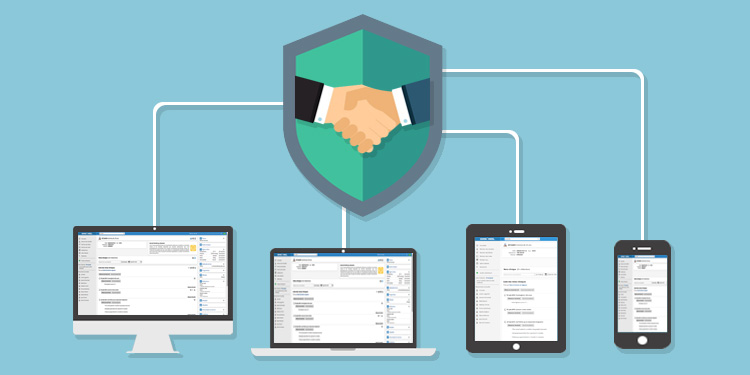
Sharing information is at the very core of our electronic medical record (EMR). In this article, we’re popularizing the notions that support the shareable record.
Why a shareable record?
The value of a network of people exponentially increases according to its number of users. Also, teamwork, collaboration, and computerization are part of the best practices to improve health care. In the province of Quebec, establishment groupings, family medicine groups (FMGs), the PQADME, systematic monitoring, and interdisciplinary work all demonstrate this.
At Omnimed, we firmly believe that the advancement of health care depends on the use of the best clinical practices that are based on conclusive data. These best practices are supported by the use of our integrating EMR. Therefore, the patient record in our EMR is shareable between health care professionals regardless of where they work.
For a given patient, this approach enables the retrieval of information that would otherwise be scattered among multiple records. The resulting clinical decisions are therefore taken quicker, they’re also more relevant and enlightened.
The confidentiality of the shareable record
In our application, the notion of shareability hangs on simple access to information regulations:
- At any time, the professional has access to the information for which he is the author.
- The professional can give access to any information for which he is the author to another professional via a mandate.
- An FMG doctor has access to all of the information of patients registered with him.
- The professional can punctually receive access to all of the patient’s records (via the button dedicated to this purpose in the record), as long as he has the explicit consent of the patient. This consent is the equivalent of receiving emergency access rights to the patient’s record.
The confidentiality of the information available in our EMR is based on recognized mechanisms, including a user consent management system that answers all of the rules mentioned above, mandates between stakeholders as well as a system that tracks all of the changes made to records. These mechanisms are in accordance with all of Canada’s and Quebec’s laws and regulations regarding the protection of personal information.
All of the actions taken in a record are logged, for audit purposes. Given the legal content of the medical record, Omnimed has obtained the ministère de la Santé et des Services sociaux’s certification[1] that consists of several stages of certification and covers, in particular, the legal, functional, technological and interoperability aspects[2]. We also obtained a confirmation from the Collège des médecins du Québec.
Access the content of the record by consent
The principle of confidentiality is regulated by two different types of patient consent in order to allow a professional to access his record: punctual consent and consent related to registration as a family physician. Refer to the following article to know more: Access the content of the patient's record with his consent.
Each punctual consent is logged into our database for audit purposes. It is therefore possible to track at any time who has accessed the content of a patient record.
Action log system
Action logs will help you keep track of the actions that are taken in the patient record, whether it be by you or by a person from whom you have obtained a mandate. Our action log system is already integrated into Omnimed. Any action is automatically recorded in our system. Most of these actions are directly visible from the patient’s record: Clinical note content.
We have provided you with two reports that allow you to obtain a list of consultations and consents for a patient, as well as a list of records consulted by a user. You will find in the following article a description of each of these reports: Consultations of records and consents.
Confidential field
We observed a growing need related to the confidentiality of certain information mainly when requested by a patient. Whether it’s the patient’s request or a professional decision, the doctor can decide that information must stay between him and his patient. In order to answer this specific need and to respect the trust established between the professional and the patient, we decided to create a confidential field that will be attached to the clinical note. This field allows the input of information only available to its author.
References
[1] Ministère de la Santé et des Services sociaux, Bureau de certification et d’homologation, Produits et services technologiques certifiés « Dossiers médicaux électroniques (DMÉ) », mai 2020, en ligne.
[2] Ministère de la Santé et des Services sociaux, Certification et homologation, Homologation, en ligne.
[3] Régie de l’assurance maladie du Québec, Formulaire Inscription auprès d’un médecin de famille, consulté le 28 mai 2020, en ligne.